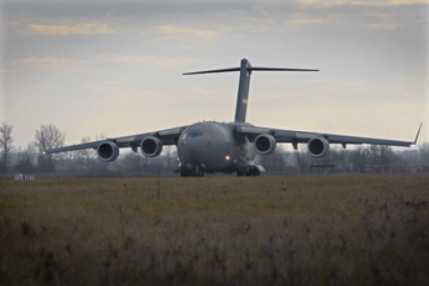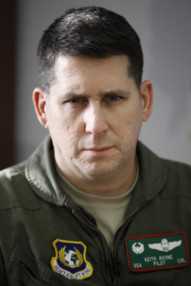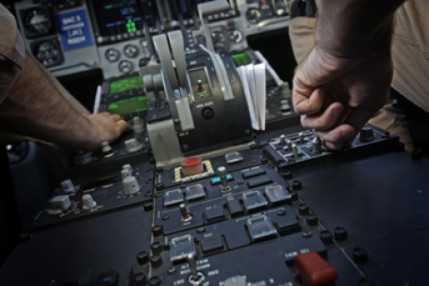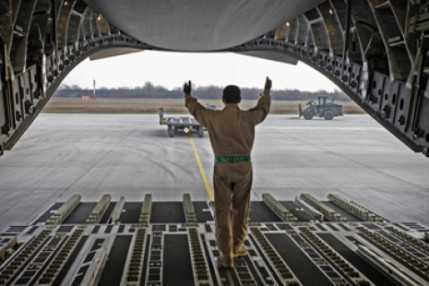From Pápa to the World
Szöveg: Gábor Kálmánfi - Boldizsár Eszes | 2012. január 27. 9:37“Anything to anywhere, anytime” – this is the slogan of the Teve (“Camel”) Squadron. The aircrews of the Kecskemét unit of the Hungarian Defence Forces fly An-26s, but as some of today’s theatres of war are thousands of kilometers away from Hungary, and the amount of cargo has multiplied, the capacity of the An-26 transport planes does not always prove to be sufficient. This problem has been solved with the activation of the Heavy Airlift Wing, a fleet of C-17s operated by a multinational team at the HDF Pápa Air Base – as these giant cargo aircraft can really transport anything to anywhere, anytime. We interviewed Col. Keith P. Boone, the commander of the Heavy Airlift Wing about the tasks, challenges and prospects of this multinational cooperation.
Colonel, let’s start with your background. Why did you choose the military career?
I wanted to go to college and I was a fairly good student, but to help out with the funding, I pursued scholarships through the US military. I was offered a US Navy Scholarship, and a US Air Force scholarship. My brother was in the Navy, so I decided to go in the US Air Force. That was my initial path to college: I pursued a technical degree in computer science, and after the first year they asked me if I wanted to be a pilot. I said „sure, that sounds good". That’s how I ended up in the Air Force…
I wouldn’t say I come from a big military family, but my nature is one of service and so this career that I chose tends to meet my personality fairly well.
What objectives did you set to yourself when you assumed command last June, and what are the things you have already managed to achieve?

Thus my first goal was to establish a way forward to reach full operational capability. The second was to work to make sure that the families that are here have a good environment where they are able to be part of the community in Pápa.
Individually we might be here for two or three or four years. Collectively, the program is here for over 30 years. People continue to come as part of the Strategic Airlift Capability, namely the foreign officers and families and members of the Heavy Airlift Wing. For us to be able to lay a foundation where the community knows that we are part of that fabric is a benefit to the program for the long term, and it’s a benefit to each member that’s here in the near term. The final part of that is to continue to work so that all the nations that are part of the Heavy Airlift Wing view themselves as one organization, the Heavy Airlift Wing as a unit. We have 12 nations, but it’s one team. We have one mission and one vision for how to go forward. We are all working together, whether it be on the job, doing the mission or out in the community – we’re all working together as one.
How is it possible to weld together 12 nations as one?

Whenever you have 12 nations with a lot of different experiences, you can always build something better than when it’s just one. So we have a lot of good things to work forward from, and we continue to see that we do that.
Operationally, because the program was developed so quickly, looking for a common baseline for everyone to start from was necessary. The US Air Force has been flying C-17s for quite a while, and I started out flying this plane in 1993. To use a common baseline, we use the C-17 regulations procedures from the United States Air Force, so that is the common baseline for the 12 nations. As we move forward, we look to those areas where we might need to deviate – to change, because we are a unique unit –, but we do it deliberately, working from something which we know.
Organizationally, we are quite different than what a US Air Force Unit would look like. So there’s a combination of two different things – from the operational norms that we fly with to the way that the unit is structured – these are two different kinds of foundations. Having 12 nations working together can be a challenge, but also there’s a lot of benefit to it, for we are doing things smarter, with a lot of good ideas coming from all the people.
How can you work together with the Hungarian soldiers, and what do you think of the only Hungarian pilot, 1st Lt. Viktor Lukács?
Viktor has done a superb job coming into the unit and flying the C-17. I’ve flown with him, he is very capable and knowledgeable, like all the different pilots, loadmasters and aircrews. It is remarkable how well everyone works together, whether they are Hungarian, Swedish or Bulgarian. Everyone works together on the aircraft as a team. You might pick up some little differences in the dialects or the variations on English – because we all use English as a common language – but otherwise everyone is very professional, including especially our Hungarian colleague.
What have your most memorable missions been in the Heavy Airlift Wing?
Unfortunately I don’t get to fly quite enough for my liking, and each one is quite memorable in its own right. On the most recent mission I flew to Afghanistan, and ran into a few challenges there…I say it’s a good thing that we have good training for us to be able to do our job. The aircrew that I was flying with performed very well, so we were able to accomplish our mission.
As an active pilot, how would you describe the advantages of the C–17 aircraft as compared to other cargo airplanes?
I started out flying C-130s, which is also a cargo airplane, a little smaller but the same type of principle. The advantage that the C-17 has is that it is very versatile in what it can carry – passengers, vehicles, or palletized cargo. It can carry air medical evacuation patients, and all the equipment is on board to be able to do that. We can do a full wide range of air delivery, so that we can airdrop personnel, equipment and supplies. It is indeed a great capability that the plane’s range is virtually unlimited. We can do air refueling and all the mission sets that the Heavy Airlift Wing does, including flying on combat missions on night vision goggles (NVG), so we are aided in flying into areas that have low illumination. It’s the same range of missions that all the units in the US Air Force do, with the exception of doing some formation flying.
The C-17 has the ability to go into small fields where it can back up with the very heavy weight; it can land on a fairly narrow runway and a fairly short runway, and it can land on unimproved surfaces. It combines the very tactical nature of the C-130 aircraft with the long-legs and the large capacity of some of the larger cargo aircraft. That alone gives us great versatility. I know because I was in the program from the beginning that the designers took into account a lot of these things, talking to pilots that have flown a bunch of aircraft and the loadmasters who work in the background. They have made a much more capable aircraft by bringing into the design a lot of the things that the workers said “this is what we need". So the versatility is part of the design and the capability.
And the versatility is in the mindset of the crews that fly it. They don’t just think it’s not just some sort of airline. They understand that it is a very serious business what we do, and the people that we bring things to need what they need, and they need it right away. The personnel of the Heavy Airlift Wing recognize that the supplies that these people desperately need – sometimes of a very critical timing and nature –, won’t get there unless we step up to do the job. The aircraft is always ready, so it is up to the human part of the system to make sure that we do our job, and everyone here has that mindset, the get-the-job-done mentality, and that’s a critical part to our Wing.
How would describe the process of air refueling?

So you fly behind the aircraft and use your navigational aids to locate each other. You fly up to a point of about 50 feet behind, then you start moving in slowly, and stop yourself when you think you’re in the right part, and the boom operator will end up extending the boom, the top of the aircraft will connect with the receptacle. Then it’s a matter of maintaining, and it’s not easy.
The most challenging flight where I had air refueling was early on, when I was learning to fly – it was my check-ride. It was the second time that I had flown air refueling at night. There were clouds so my horizon was messed up. There were some stars but you would start losing what was up and down, and your mind would play tricks on you. So I thought for sure we were nine degrees of bank the entire time of air refueling. That was very disconcerting, but I knew I had to do it… Once we’d finished with all that, it might have been cold on the airplane but I was covered in sweat. So it’s mentally challenging.
We have a lot of missions where you have to get the gas. In previous assignments we have flown injured patients from Afghanistan all the way back to somewhere in the continental United States by doing multiple air refuelings. And the person in the back’s life and death depends on your ability to get the gas, to do what you’re trained to do.
You might be scared to death at the moment just because it’s such a challenging thing to do, but your mental focus is “get the mission done because somebody depends on me!" And that’s kind of what our business is all about.
Have you ever been in a situation that was very dangerous?
Flying is an inherently dangerous business, so every time we go flying there’s always some element of danger and risk to it. Since the Wright brothers first flew in the first part of the 20th century, we have continued to get better in terms of the aircraft that we fly, and the safety approach to aviation. But the aircraft also have gotten more complex, and the systems that we fly with have gotten more complex as well.
There are different elements of risk on different flights. Just think about a training mission, a night flight, where we are flying with one of those less experienced C–17 pilots trying to do landings on NVGs on an airstrip that is 30 meters wide and 200 meters long: it is a challenge in itself. Or think about the areas where we fly to: we fly all over Europe, so we will be flying in areas where the weather becomes the challenge. That’s a risk. In the winter weather there’s a lot of snow and ice that you have to deal with. And certainly there is a challenge when we’re going to Afghanistan – you only need to read the papers to see that it is still not a safe area. The lots of missions we are flying into that area are a challenge. We do that routinely, but it is far from routine. We have to be on our guard every time we fly somewhere, and we have to be mentally prepared. That’s why we train as hard as we do, so that we can accomplish the mission safely, and bring back the people we need to bring back, including ourselves.
What are the tasks ahead of the Wing for this year?

All twelve nations including Hungary have made investment in this program, so each nation should get a certain amount of flying hours per year for their investment. The 3165 hours is the full operational capability number. But that is not just for this year, we need to be able to do that for 2013 and 2014, and maybe for thirty years or more, however long the program goes. And so we have to work out processes, we have to get better tools for planning and command and control. We have a manpower study to see if we have the right people in the right places to do the right job to be able to sustain that. We have infrastructure needs that we continue to work towards with the nations. All those things are going on in 2012 − we are really trying to make an effort to reach full operational capability so that the nations are getting their return on their investment.
The other side of the 2012 coin is focusing on the teamwork. It’s the teamwork within the Heavy Airlift Wing, it’s the teamwork within the families that are part of the Heavy Airlift Wing program, and then it’s the teamwork with the community. With all three of those, we’re continuing to make better efforts to work together and enjoy our time. There has got to be an element of fun and camaraderie to our job, so we have to get together and enjoy our life here in Hungary.
How do you find living here in Pápa?
I find Papa and Hungary to be beautiful, with extremely gracious and wonderful people to live around and be part of the community. It’s a great place to live and work.
It is probably impossible to put twelve nations in any community in any nation anywhere in this world without there being some challenges to work through. So certainly we have challenges we’ve have worked through, and we continue to work through them. Probably, the biggest challenge is the language, because Hungarian is a challenging language that none of the twelve nations naturally speak save Hungary.
But there will be a natural evolution of this, year by year we’re making things better, so the members of the Heavy Airlift Wing better integrate into the community and the community better understands what is helpful and advantageous to the Heavy Airlift Wing families. It’s a mutual support relationship.
The things that are closest and most meaningful to the family members that live here are your housing, where you live, your children’s welfare – so the schools –, and then the medical care. Those three are probably the biggest three areas where we have to put a concentrated effort to make sure that families have what they need to be able to live here – and not just live here, but want to live here. We recognize national days and try to celebrate those, so that we all can identify with the histories and the cultures which draw us closer together, by celebrating the uniqueness of the individual nation.
How would you characterize your relationship with the leaderships of Pápa and the Hungarian Defence Forces?
We continue to work very hard with the town. We are trying to identify the areas where we can make things better for all the nations, because while I wear the American flag on my sleeve, I truly view myself as representative of all twelve nations including Hungary in the Heavy Airlift Wing. There are challenges in every area but there is progress in every area too, as I see a lot of genuine caring responses from the town whenever it comes to finding the ways to make things better. So the relationship between the Heavy Airlift Wing and me personally, with the leadership of Pápa Air Base, – Col. Miklós Domonkos – with the mayor of the town and the Hungarian Ministry of Defence is very strong and positive, and everyone is very willing to take a good strategic look on ways that we can move forward, and I really appreciate all the cooperative efforts that go into it. We’re excited to be part of Pápa and Hungary, we enjoy the mission here, and certainly look forward to this program over a long-long time getting better and better.
What are the benefits of cooperation to the twelve nations within this program?

To have partnerships with the twelve nations that go beyond just NATO to our Partnership for Peace nations of Finland and Sweden is also a great thing, because it helps us to learn things that are just beyond the NATO Alliance. The opportunities for Hungary are significant. Hungary should take great pride in having the Hungarian flag on the tail of these C–17 aircraft, the only ones that are stationed in Europe – and there’s the economic opportunity for Papa, more population at the Base – not just us, but more Hungarian soldiers here at the base is also a good opportunity – and the potential is even greater.
Investments in the base or the infrastructure provide better opportunities for multimodal transportation. It’s cheaper for the nations, and it helps the program overall. What we have is a foundation which we are making broader, and I think that is a great opportunity for Hungary to seize upon it quickly, to allow it to get a good return over the life of the program.
How do you see the future of these programs? Is it the way of the future to put all efforts together?
In NATO the term ‘Smart Defence’ is used. But the cooperative effort is certainly a good way forward. And there are different models out there. This is one which has shown itself to be very effective, with different nations investing into a common pool that they collectively own.
At the European air transport command, four nations combine the resources they own within common command and control. That works well if you own the planes, but if you don’t own the planes, you can’t enter into that sort of cooperation. So you have the requirement but you don’t have the resources.
Thus, ours is a very good way to go, and you’ll see it from ISR – intelligence, surveillance, reconnaissance – as there is some movement trying to do this with ISR platforms, and there is a potential for doing this with tanker platforms – so there is a lot of opportunity for this sort of cooperative effort.
I do think it is the way forward that you’ll see perhaps in other continents like Africa, where there’s more pooling and sharing which can be done.
Photos: Veronika Dévényi